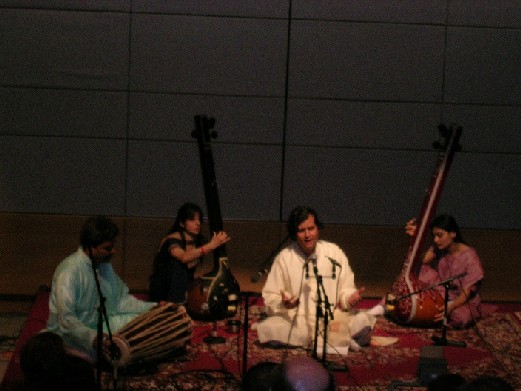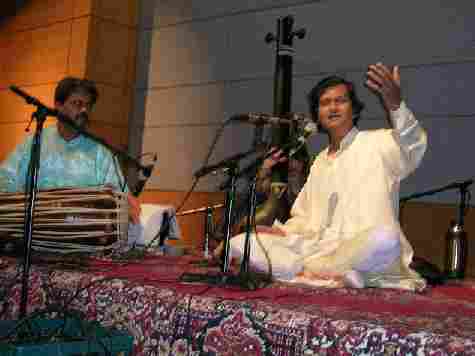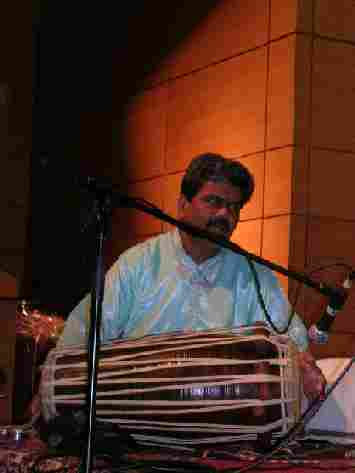Contribute
| Uday Bhawalkar Presents Dhrupad At MITHAS Concert |
Shuchita Rao
03/16/2005
In the present times, artists feel compelled to present their best tricks in the shortest amount of time. Yet, when Uday Bhawalkar opened his Dhrupad concert with Raga Bhimpalaas and sang it for over two hours on Dhrupad is the oldest form of North Indian Classical Music. The origin of this music is linked to recitation of SamVed. The nature of the music is spiritual, inducing a feeling of peace and contemplation in the listener. An American MIT student who sat next to me shared her feelings about Dhrupad music. "I like the way the musician's voice is weaving in and out of the drones of the tamboora instrument. It is very relaxing" Michelle said. Uday Bhawalkar spoke to Lokvani about Dhrupad. Tell us about the evolution of Dhrupad. Dhrupad is as old as the Vedas. It probably evolved from chanting of What attracted you to learn Dhrupad style of Music? As a child I loved Raagdaari Sangeet meaning music based on ragas. I lived in a village in Madhya Pradesh and studied at a music school. My sister used to sing and she influenced my interest in music. In my village, there were no regular music concerts , we enjoyed them whenever they happened and we listened to the radio a lot. One day, I applied to an advertisement in the newspaper that invited students to learn forms of music such as Dhrupad, Tappa and instruments such as Pakhawaj and Saarangi, which needed to be encouraged and revived. Dhrupad Kendra in Describe your music routine as part of GuruShishya Parampara. I woke up at 4A.M in the morning. I learnt for about 8 hours a day from my Guru and we talked about music and other things all day long. The learning was unhurried. I cared for my Guru because of a natural love for him and I submitted my work to him. I did not learn with the intention to perform. I learnt for the sake of my passion for music. What are your goals in life? First and foremost, my goal is to preserve the knowledge given to me by my Gurus in as pure a form as possible by practicing it regularly. Second, I want to teach Dhrupad singing. Finally, I want to perform so members of the larger society can know about Dhrupad. You have a wonderful voice and you have done playback singing for movies such as Mr. and Mrs. Iyer. Have you considered singing any other popular form of music besides Dhrupad? No, I am not in favor of singing anything else but Dhrupad.. I do not want to offer a Supermarket model where I can offer a great variety of products. I like to dedicate my singing to just to Dhrupad. What do you feel inside you when you sing Dhrupad? I use my voice in two and a half octaves when I sing Dhrupad. I believe in singing with Bhaav (with feeling.) If there is no bhaav, there is no soul in the music. Feelings can be conveyed by words or just by notes. A note (Swar) or Naad is quite complete in itself. There is actually no need for words or rhythm to bring out its power and beauty. As part of Dhrupad Alaap development, I do use phrases such as Ree Na Raa Na or Da Na Ra Na , These phrases do not come out in just one monotonous way or evoke one single feeling when I sing them. Sometimes, I see a child in them, at other times, nature, GOD, and even drama/theatre where I can visualize feelings of anger or love and so on. The picturisation goes beyond note and sound. I explore each note in every way possible and talk to it. It is important for me to listen to my notes and to feel the joy in them only then will my listeners feel the joy in them. What should a performer keep in mind during a performance? I believe that a performer is a creator. There must be spontaneity in the art. I do not plan my concert in advance. I do my work without desire for reward or successful outcome. I practice for the sake of Riyaz or practice just as I perform for the sake of singing and self-realization.
You may also access this article through our web-site http://www.lokvani.com/


